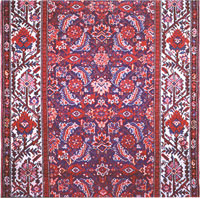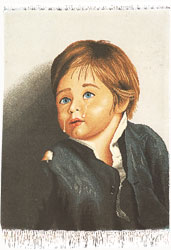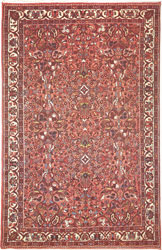Before talking about the variety ot the design, it is oppotune to mention that all the designs can basically be categorised into three principal groups. All the motifs and figures which constituted the design are made from composition contact, rotation and balance of the lines.
If the lines along their route make angles the design is in geometrical style. But if the lines in their course don't make angles, the design will be classified in the curvilinear group. Should the lines of the design in some part of their route make angles and in others make roundish movements the design belongs to the stylised group. Most Persian carpets are decorated with medallion (Toranj) and corners ( Lachack ).
The medallion is always located in the centre of the LAYOUT and the shape may be round, oval, rhomboid or radial of different sizes which varies according to the taste and custom of the weavers. INSTEAD of a single medallion we may find two or three medallions on the central line of the carpet. Usually on the top and bottom of medallion there are two pendants (Sartoranj). One fourth of the medallion shape or something of a similar from when repeated in the corners of the field is named corner Lachack. All Persian designs are categorised in two groups.
A : Tribal designs There designs
have been influenced by old and noble Persian Patterns that were created
by the native carpet weavers. The simplicity of l ife
enjoyed by the weavers is reflected in the style of their production. In
spite of the patterns, which are not ordered and regular, the designs are
still attractive and pleasant.
ife
enjoyed by the weavers is reflected in the style of their production. In
spite of the patterns, which are not ordered and regular, the designs are
still attractive and pleasant.
The designers have transferred these patterns from one district to another so that these designs can be found from the furthest east to the furthest west of the country. Sometimes these designs are recognised by the name of the production zone such as Mazlaghan, Ferdous, Veis, and may take the name of the Chieftain such as salar - Khani, Yaghub - Khani, Ali - Mirzai, Heibatlu is one of the most famous patterns of this group which is associated to Abadeh in the province of Fars . Most tribal designs are in geometric and stylised style.
Tribal carpets and small in size woven in a very short period of 3 or 4 months and in the form of a rug and runner . The tribal looms are made horizontally, easy to dismantle and pack to be loaded on horses, camels and other load carrying animals, with speed and ease.
The rugs are thick and woven in natural, sharp and bright colours. The knots are generally Ghiordes and sometimes Senneh.
The nomads often prefer geometrical designs, which they themselves create. Evidence also is the use of heraldic emblems of tribal coats - of - arm and evern motifs.
B : Urban designs The designs of Urban carpets in comparison to tribal patterns are more elaborate and precise, therefore to realise them the weaver needs to use the tenplate.
Every compartment of this millimetric sheet represents one knot of the carpet. Here below we study fourteen kinds of designs:

B1 : Medallion carpet
Medallion carpets are one of the earliest designs attributed to the beginning of the Safavid dynasty. If one quarter of the medallion or similar shape is repeated on four sides of the field, the design is further designated as a corner medallion.

This modern example in cuvilinear style counts as one of the most interesting and beautiful of known Esfahan rugs. Inside of the persian flag is inscribed made by bahram Enteshari in Esfahan - Iran
B2 : Shah - Abbasi design The basic sketch is formed from specially designed flowers, which are known as shah - Abbasi . it is set off by other floral designs and occasionally Eslimi motif, these abstract flowers from the main design in the field and the border, all over (Afshar), medallion, Sheikh - Safi , tree , animal , turreted medallion are the better known in the secondary group of this design.

B3 : Arabesque (Eslimi) Abstract circular branches of a tree amidst leaves are the basic form of this design. The branches are adorned with foliate spurs known as Eslimi. There are many kinds of Eslimi designs predominating in some carpets of which the Dahan Ajdari is the best known.

B4 : Vase (Goldani) The shape of the vase in different sizes can be seen in the carpet of this category . Some large vases are repeated throughout the ground. Mehrabi vase , Zell - e - Sultan vase , Haj khanumi vase, all over vase are the minor groups of this design.

B5 : Harati design This beautiful nomadic design was created in the city of Harat (the capital of Timur) now in Afghanistan. A basic sketch is formed from a central diamond shaped figure framed by four slightly curling leaves which could be repeated in the field and the borders. Entwined fish (Mahi - dar - ham) pattern is one of the sub - patterns of this category which was produced for the first time in Khorasan but gradually it found its way to other carpet weaving areas of Iran. Sub - Patterns are: Mahi (fish) Farahan , Mahi Sanandaj.

B6 : Tree design The base of this design is a tree Sub - patterns include : tree and animal floral profusion vase tree cypress tree.

B7 : Botteh design ( Paisley Pattern) The Botteh design is the abstract from cypress tree common in both Indian and Iranian patterns from olden times and for many years it had a good market. There are various forms and sizes in the Botteh designs in Iran. The famous one of this category are: Botteh jegheh, Botteh terme, Botteh saraband or Botteh Mir, Botteh Ghalamkar Esfahan , Botteh Kordestani and Bottehn Afshari.

B8 : Panel design The field of the carpet in this design is divided by some lateral panels and the carpet looks like a chessboard. The interior of each panel is decorated by the traditional motif of each district such as vase, Botteh, bunch of Grapes, Willow, flowers, birds, animals etc. This design which is originally from Bakhtiari area, is appreciated also by the craftsmen of Tabriz, Ghom , Birjand. Sub- patterns are Baktiari panel, Eslimi panel.

B9 : Historical building design To create these designs the inspiration has been taken from the tile work and architecture of ancient buildings. In the course of history carpet designers have copied the main patterns and created similar designs. Some of the most famous of the relic are Sheik Lotf - ollah mosque, Takhte - Jamshid ( persepolis), Taghe - Bostan.

B10 : Portrait and pictorial design In this kind of designs, political personages, portratis, landscapes and painting are depicted and constitutie the main subjects of this category which are common in the high level workshops of Tehran, Tabriz, and Kerman.

B11 : Prayer (Mehrabi)design The prayer niche in the mosque where the Imam prays inspires the basic design of the rug. Some ornaments such as columns, headband, candelabrum (Ghadil), Shah Abbasi flowers, may enrich this design. Among the numerous variations are tree prayer (Mehrabi Derakhti), vase prayer (Mehrabi Goldanili). Candelabrum prayer (Mehrabi bhandili)

B12 : Afshan design Normally in carpet designs all the components and forms are joined and linked together as if the painter's pen has never ceased its movement from the beginning until the end of the sketch. In the Afshan design the flowers branches and other motifs are scattered on the surface of the carpet without being joined. Well - Known patterns in this group are : Afshan Shah Abbasi, Afshan bouquet of flower, Afshan gol Farang.

B13 : Interconnected (Bandi) design When a small portion of a design is repeated and connected throughout the length and width, the pattern is called interconnected(Bandi). Sub Patterns of this group are Known as Bandi Varamin or Mina - Khani , Bandi Eslimi, Bandi Mollah Nasreddin, interconnected , cartouche, interconnected deer horn ( Bandi Shakh Gavazni ).

B14 : Striped (Moharramat) design This name is applied to designs which are repeat in narrow strips along the length of a carpet Each strip has its own specific colour and design in some areas of Iran this pattern is also known as Ghalamdani.Botteh Moharramat is one of the sub- Patterns of this design.

Subdivision according to size Persian carpets are generally woven in the following standard size.
| Description | Persian version | Approximate size in cm. |
| Very small rug | Poshti or Padari | 60x90 |
| Small rug | Zar - o - charak | 80x130 |
| Small rug | Zar - o - nim | 100x150 |
| Medium/small | Ghalicheh | 130x200 |
| Medium rug | Sajjadeh or Do - zar | 150x210 |
| Large rug | Pardeh | 150x250 |
| Small carpets | Ghali | 200x300 |
| Medium carpets | Ghali | 270x370 |
| Large carpets | Ghali | 300x400 |
| Short runner | Kharak | 70x180 |
| Long runner | Kenareh | 70-110x280-1600 |
| Wide runner | Kalleghi | 120-180x250-500 |